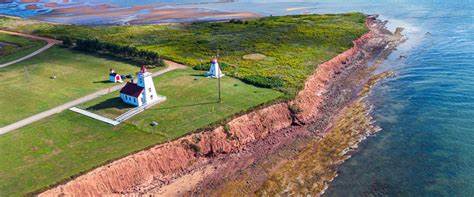Cape Bear Lighthouse is a historic lighthouse located on the southeastern coast of Prince Edward Island, at the entrance to the Northumberland Strait. Built in 1881, the lighthouse is significant for both its role in guiding ships safely along the coast and for its connection to early communication technology. The site is most famously known for being the place where the first distress signal from the Titanic was received.
The Marconi Site is an important historical location connected to Guglielmo Marconi, the inventor of wireless telegraphy. In 1902, Marconi’s wireless station was established at Cape Bear, where the first wireless distress signal from the sinking Titanic was received. The Marconi connection is a key part of the site’s history, making it a unique blend of maritime and telecommunication history.
Today, the Cape Bear Lighthouse and Marconi Site serves as a museum, a heritage site, and a place for learning about both local maritime history and the early development of wireless communication technology.
Things to Do and Activities at Cape Bear Lighthouse and Marconi Site
Visitors to Cape Bear Lighthouse and Marconi Site can engage in a variety of activities that allow them to explore the area’s natural beauty as well as its historical significance:
1. Visit the Lighthouse
- Explore the Lighthouse: The Cape Bear Lighthouse is the main attraction, where you can learn about the lighthouse’s construction and its role in guiding ships safely through the Northumberland Strait. The lighthouse is open to the public, and visitors can take guided tours to learn more about its history.
- Climb the Lighthouse Tower: One of the main draws of the lighthouse is the opportunity to climb to the top. From the tower, visitors are treated to stunning panoramic views of the coastline and the Northumberland Strait, making it a great spot for photography.
- Photography: The lighthouse itself and its surroundings are very photogenic, offering excellent opportunities to capture the beauty of the coast, especially during sunrise or sunset.
2. Marconi Wireless Station Museum
- Historical Exhibits: The Marconi Site features a museum dedicated to the history of wireless communication and Guglielmo Marconi’s contributions to telegraphy. The museum showcases artifacts, photographs, and displays detailing the role of the wireless station at Cape Bear.
- Learn about Titanic’s Distress Signal: One of the most significant events in the history of Cape Bear Lighthouse and the Marconi site is that it was the location where the first distress signal from the Titanic was received. You can learn about this historical moment and see exhibits related to the Titanic disaster.
- Interactive Displays: The museum includes interactive exhibits where you can see how wireless telegraphy worked and gain a better understanding of how this technology revolutionized communication.
3. Scenic Walks and Outdoor Exploration
- The lighthouse is located on a cliff overlooking the sea, and the area around it offers some beautiful walking trails. These trails offer views of the coastline and allow you to explore the natural beauty of the surrounding landscape.
- The grounds around the lighthouse are also perfect for a leisurely stroll or picnic. The location is peaceful and offers a great opportunity to relax and enjoy the ocean breeze.
4. Learn About Local Maritime History
- The Cape Bear Lighthouse is part of Prince Edward Island’s rich maritime history, and the site provides an opportunity to learn about the local seafaring past. You can gain insights into how the lighthouse was used to guide ships through the treacherous waters of the Northumberland Strait, a vital task for sailors in the 19th and 20th centuries.
5. Special Events and Programs
- The Cape Bear Lighthouse and Marconi Site hosts various special events and educational programs throughout the year, particularly in the summer. These can include historical talks, maritime-themed events, and educational workshops for all ages.
- The lighthouse occasionally offers night tours or special events during historical anniversaries, like the Titanic anniversary, making it a perfect time for history buffs to visit.
Best Time to Visit Cape Bear Lighthouse and Marconi Site
The best time to visit Cape Bear Lighthouse and Marconi Site depends on what kind of experience you’re looking for:
Summer (June – August)
- Summer is the peak tourist season, and it’s the most popular time to visit the Cape Bear Lighthouse and Marconi Site. The weather is warm, and all the exhibits, lighthouse tours, and activities are in full swing. You’ll also have the chance to explore the coastal views and enjoy the outdoors in the best conditions.
- During summer, the site often hosts special events and programs, and the museum is open daily. It’s also the best time for photography, as the area is vibrant and lively.
Fall (September – October)
- Fall is a great time to visit if you prefer a quieter experience with fewer crowds. The weather is still mild, and the fall foliage in the area creates a beautiful backdrop for photographs. The lighthouse and Marconi Site remain open, but some events may be limited.
- Fall is perfect for a more relaxed visit and for those who enjoy hiking and outdoor exploration, with cooler temperatures ideal for walking.
Spring (April – May)
- Spring is the off-season at Cape Bear Lighthouse and Marconi Site. The weather is cooler, and some of the activities may not be fully operational yet. However, spring is an excellent time for quieter exploration of the site and its surroundings.
- The natural beauty of the area begins to bloom in spring, so you can enjoy early wildflowers and the beginning of the coastal greenery.
Winter (November – March)
- Winter is the least popular time to visit Cape Bear Lighthouse, as the weather can be cold and windy, and the site may be less accessible due to snow or ice. Some facilities may be closed, and the lighthouse might not be open for tours.
- However, winter offers the opportunity for solitude and a peaceful atmosphere. The coastal views during a snowstorm or on a crisp, clear winter day can be stunning, making it a good time for photography if you don’t mind the cold.
Where to Stay Near Cape Bear Lighthouse and Marconi Site
There are several options for accommodation near Cape Bear Lighthouse:
- Local Inns and Bed and Breakfasts: There are various B&Bs and small inns in nearby towns like Morell and Cardigan, offering cozy and comfortable places to stay with easy access to the lighthouse.
- Resorts and Hotels: For more extensive amenities, you can stay in larger resorts or hotels in Charlottetown (about a 30-minute drive away) or Montague.
- Camping: If you prefer a more rustic experience, there are campgrounds in nearby Prince Edward Island National Park or other areas around the island.
Dining Options
- Local Cafés and Restaurants: There are several quaint local cafés and restaurants in nearby towns such as Morell and Cardigan where you can enjoy local PEI seafood, fresh produce, and more. Options range from casual seafood shacks to sit-down restaurants serving island specialties like lobster, mussels, and potatoes.
- Picnicking: The area around the lighthouse is beautiful, with picnic areas available for visitors. If you pack a lunch, you can enjoy a relaxing meal with a view of the ocean.
Why Visit Cape Bear Lighthouse and Marconi Site?
Cape Bear Lighthouse and Marconi Site is an essential destination for history enthusiasts, maritime lovers, and anyone interested in the development of communication technology. The site offers a unique combination of historical significance and natural beauty, making it a fascinating and educational place to visit.
From the historical importance of receiving the Titanic’s distress signal to exploring the roots of wireless communication, Cape Bear Lighthouse and Marconi Site offers an immersive experience into early 20th-century history. The stunning views of the Northumberland Strait and the surrounding landscape only add to the appeal of this remarkable site.




